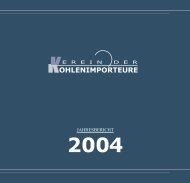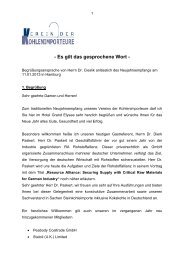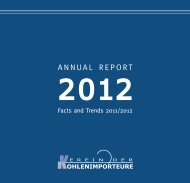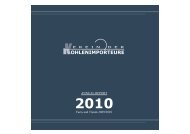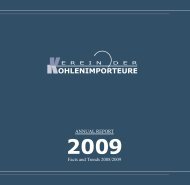Annual Report 2010 - Verein der Kohlenimporteure eV
Annual Report 2010 - Verein der Kohlenimporteure eV
Annual Report 2010 - Verein der Kohlenimporteure eV
You also want an ePaper? Increase the reach of your titles
YUMPU automatically turns print PDFs into web optimized ePapers that Google loves.
for companies participating in the EU ETS already<br />
partially contributed to reducing emissions. Verified<br />
<br />
billion tonnes of CO 2 equivalent.<br />
Success in reducing CO 2 varies widely across the EU-<br />
15. While industrial heavyweights in the EU, Germany<br />
and the United Kingdom, have largely met their goals,<br />
most of the other Member States fall somewhat short.<br />
In those countries with most economic growth, CO 2<br />
emissions will have risen further compared with 2009<br />
(figures for <strong>2010</strong> are not yet available).<br />
EU-15 CO 2 Emissions<br />
Baseline Year<br />
1990 (MtCO 2<br />
equivalent)<br />
EU Objective<br />
2008-2012<br />
compared with<br />
Baseline Year (%)<br />
Change<br />
1990-2008<br />
in %<br />
EU-15 4,227.2 - 8.0 - 6.5<br />
Germany 1,253.3 - 21.0 - 22.2<br />
United<br />
Kingdom<br />
746.0 - 12.5 - 18.6<br />
Denmark 69.0 - 21.0 - 7.4<br />
Luxemburg 12.7 - 28.0 - 4.8<br />
Belgium 146.8 - 7.5 - 7.1<br />
Austria 78.0 - 13.0 + 10.8<br />
Finland 76.8 0.0 - 0.5<br />
France 546.7 0.0 - 6.4<br />
Greece 107.0 + 25.0 + 22.8<br />
Ireland 53.4 + 13.0 + 23.0<br />
Italy 508.0 - 6.5 + 4.7<br />
The<br />
Netherlands<br />
212.5 - 6.0 - 2.4<br />
Portugal 57.9 + 27.0 + 32.2<br />
Spain 286.8 + 15.0 + 42.3<br />
Sweden 72.3 + 4.0 - 11.7<br />
HT-EU2 Source: IWR/European Environment Agency<br />
The table shows that without the contributions of the<br />
<br />
would fall far short of its targets, with an absolute<br />
increase in CO 2 emissions. The success of reducing<br />
emissions in Germany has been largely a consequence<br />
of the transitional economic situation in East Germany.<br />
The United Kingdom profited from the downsizing of<br />
its coal mining industry by 80 million tonnes during<br />
the period 1990 to <strong>2010</strong>. Over the same period, the EU-<br />
10 countries recorded a 23% drop in emissions due to<br />
the collapse of industrial output in many countries of<br />
Eastern Europe. In other words, a major portion of the<br />
reductions are due to one-off effects that will not be<br />
repeated.<br />
Including these countries, the EU has made progress in<br />
<br />
<br />
thereby already close to the 20% reduction objective for<br />
2020.<br />
The EU-10 states, following their accession, will<br />
presumably begin a stronger growth phase, with a<br />
simultaneous rise in energy requirements. However, this<br />
may now be delayed by 2-3 years owing to the economic<br />
crisis, with nearly all new Member States being affected<br />
yet with a positive effect on the EU’s CO 2 inventory.<br />
EU Hard Coal Market Still Declining<br />
In <strong>2010</strong>, small reductions in the output of European<br />
hard coal were registered in some countries alongside<br />
small increases in others. This resulted overall in 1.4<br />
million tonnes less production in <strong>2010</strong>.<br />
Bulgaria + 0.1 Mt<br />
Germany - 1.0 Mt<br />
Poland - 0.9 Mt<br />
Spain + 0.6 Mt<br />
<br />
Romania 0.0 Mt<br />
United Kingdom + 0.3 Mt<br />
<br />
Poland and Spain in the next few years following the<br />
European Commission’s Decision on State Aid of<br />
December <strong>2010</strong>.<br />
31



